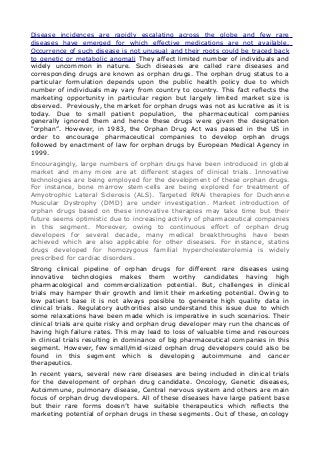
Global orphan drug market future outlook 2020
- 1. Disease incidences are rapidly escalating across the globe and few rare diseases have emerged for which effective medications are not available. Occurrence of such disease is not unusual and their roots could be traced back to genetic or metabolic anomali They affect limited number of individuals and widely uncommon in nature. Such diseases are called rare diseases and corresponding drugs are known as orphan drugs. The orphan drug status to a particular formulation depends upon the public health policy due to which number of individuals may vary from country to country. This fact reflects the marketing opportunity in particular region but largely limited market size is observed. Previously, the market for orphan drugs was not as lucrative as it is today. Due to small patient population, the pharmaceutical companies generally ignored them and hence these drugs were given the designation "orphan”. However, in 1983, the Orphan Drug Act was passed in the US in order to encourage pharmaceutical companies to develop orphan drugs followed by enactment of law for orphan drugs by European Medical Agency in 1999. Encouragingly, large numbers of orphan drugs have been introduced in global market and many more are at different stages of clinical trials. Innovative technologies are being employed for the development of these orphan drugs. For instance, bone marrow stem-cells are being explored for treatment of Amyotrophic Lateral Sclerosis (ALS). Targeted RNAi therapies for Duchenne Muscular Dystrophy (DMD) are under investigation. Market introduction of orphan drugs based on these innovative therapies may take time but their future seems optimistic due to increasing activity of pharmaceutical companies in this segment. Moreover, owing to continuous effort of orphan drug developers for several decade, many medical breakthroughs have been achieved which are also applicable for other diseases. For instance, statins drugs developed for homozygous familial hypercholesterolemia is widely prescribed for cardiac disorders. Strong clinical pipeline of orphan drugs for different rare diseases using innovative technologies makes them worthy candidates having high pharmacological and commercialization potential. But, challenges in clinical trials may hamper their growth and limit their marketing potential. Owing to low patient base it is not always possible to generate high quality data in clinical trials. Regulatory authorities also understand this issue due to which some relaxations have been made which is imperative in such scenarios. Their clinical trials are quite risky and orphan drug developer may run the chances of having high failure rates. This may lead to loss of valuable time and resources in clinical trials resulting in dominance of big pharmaceutical companies in this segment. However, few small/mid-sized orphan drug developers could also be found in this segment which is developing autoimmune and cancer therapeutics. In recent years, several new rare diseases are being included in clinical trials for the development of orphan drug candidate. Oncology, Genetic diseases, Autoimmune, pulmonary disease, Central nervous system and others are main focus of orphan drug developers. All of these diseases have large patient base but their rare forms doesn’t have suitable therapeutics which reflects the marketing potential of orphan drugs in these segments. Out of these, oncology
- 2. segment has got maximum attention followed by rare genetic disorders, neurological disorder and autoimmune disorders. In a bigger view, orphan drug segment is expected to grow several folds in coming years due to several favorable factors. Introduction of innovative technologies, favorable pricing, reimbursement, unmet medical necessities and strong clinical pipeline could be attributed as important factors responsible for their growth. "Global Orphan Drug Market Future Outlook 2020" report highlights: • Global Orphan Drug Market Overview • Global Orphan Drug Market Segment Analysis • FDA & EMA Regulation for Clinical Trials Orphan Designated Drugs • Orphan Drug Designation Criteria & Reimbursement Policy by Region • Comprehensive Insight on Global Orphan Drugs Clinical Pipeline & Patent Analysis by Company, Country, Indication & Phase • Global Orphan Drugs Clinical Pipeline: 697 Drugs • Majority Orphan Drugs in Phase-II Trials: 249 Drugs • Marketed Orphan Drugs: 274 Drugs
